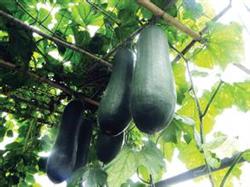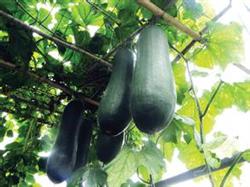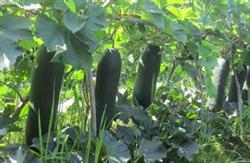Cultivation points and technical methods of summer wax gourd

Summer wax gourd is usually sown from June to July and planted from August to September. Because its growth is in the season of high temperature and humidity, it aggravates the contradiction between fertilizer and water supply and growth and development, especially pruning is the key to affect the commercial yield of wax gourd, to achieve a yield of more than 4000 kg per mu, the main points of cultivation are as follows: first, when the seedling age of wax gourd reaches 30 days and grows to two leaves, the seedlings with developed root system, short thick and thick stems, thick leaves and no damage are selected. Generally, only the main vine is left, 900 trees per mu are planted, while those cultivated with two vines are planted, 400 Mu plants are planted. 2. Reasonable topdressing seeds and seedlings 1000 kg of human feces and urine after living trees; when melons grow to 5kg, acupoints apply 5kg of human feces or 0.1kg of urea; when melons grow to 15Mel 20kg, acupoints apply 5kg of human feces and urine or 0.2kg of urea. In the future, if the seedling color is light, you can chase 2Mel 3 kilograms of human feces per litter. Third, pruning is an effective measure to increase yield, control excessive growth and ensure consistency in melon size. Generally, only the main vine is cultivated, with about 24 leaves or leaving melons after the second female flower blossoms, leaving 3 melons in each plant. After the second or third melon is seated, leave 5 leaves in the back of the melon, remove the terminal buds, get rid of the old leaves, cut off the lateral branches and axillary buds; in the cultivation of main and auxiliary vines, the position of the main vines is the same as above, and when the lateral vines grow about 20 leaves, leave melons, other requirements are the same as above. Due to the difference of environmental conditions, the location and number of remaining melons have changed, but it is necessary to prune and cushion melons, and it is better to stand upright. Fourth, the diseases and pests of wax gourd include quenching disease, Fusarium wilt, blight, aphids, grubs and so on. The quenching disease can be prevented and treated with 75% chlorothalonil 1000 times or 20% dimethophos 1000 times, Fusarium wilt can be controlled with 50% carbendazim or 20% methyl fumarate EC, and the epidemic disease can be sprayed or irrigated with 50% carbendazim or 50% nail cream copper 600 times solution, each plant is irrigated with 0.3% 0.5 liter per plant, once for 10 days, and the effect is good for 3 times in a row. The control of aphids can be controlled with dimethoate 800x or trichlorfon 1000 times, and grub can be irrigated with 1000 times of phoxim or 1000 times of trichlorfon. Fifth, harvest when the furry of melon flour gradually fades, and when white powder appears near the stalk, it can be harvested one after another. If the market is good, tender melons can be listed on the market to improve efficiency.
- Prev

Efficient Cultivation Techniques for Small Wax Gourd
Heipi winter is the largest winter melon variety cultivated in South China, with an annual planting area of more than 800,000 mu. At present, the main varieties of black skin wax gourd are still farm varieties. Due to the increasing requirements of the market for product quality and the serious occurrence of diseases and insect pests in vegetable areas, farm varieties are difficult to meet the needs of production.
- Next

High-yield cultivation techniques of Green skin Wax Gourd
Green-skinned wax gourd is widely cultivated in North China, with strong adaptability, high yield, storage tolerance and transportation. The high-yield cultivation techniques are introduced as follows. First, sowing and raising seedlings 1. Seed treatment. Wax gourd seeds are not easy to absorb water because of their thick seed coat, so seed soaking and seed disinfection should be carried out before sowing. Use more than 50% carbendazim 25.
Related
- Where is it suitable to grow horseradish in China? it is expected to see the middle altitude horseradish in Alishan.
- How to prevent tomato virus disease reasonably? (Control methods included)
- Many people like to plant towel gourd on the balcony. What are the main points of this method and management?
- What crops can chili peppers be mixed with?
- Fertilization techniques and matters needing attention in Tomato
- What are the grafting techniques for peach seedlings in spring?
- Harm and control methods of root swelling disease of Chinese cabbage
- What are the pests of sweet potatoes? How to prevent and cure it?
- Symptoms, causes and Control methods of navel Rot in Tomato
- The cause of "Cucumber rotten bibcock" in Farmers' planting Cucumber and its Control Plan

